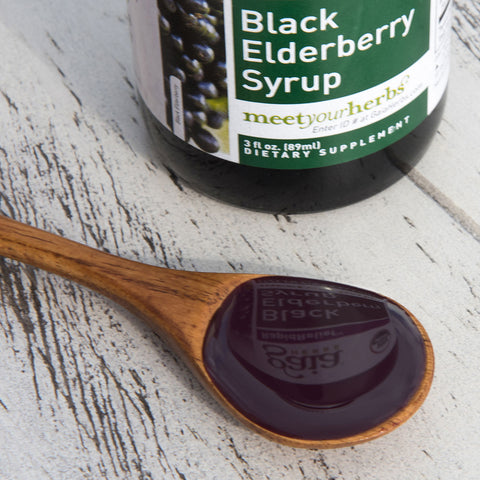The humble Black Elderberry has recently surged in popularity, outpacing Echinacea as America's go-to herb for handling immune challenges. This small tree or shrub grows in much of Europe and throughout the United States. In the late fall, it produces dangling clumps of juicy dark purple berries that have traditionally been used as a food in brandies, wines, juices, soups, syrups, pies, and preserves, and as a natural remedy for strengthening the natural defenses.* Clinical trials conducted over the past 15 years have validated its traditional medicinal use, showing it supports both short and long-term immune function.*
Tried and True
Elderberry was so named because Native American herbalists regarded it as a wise "elder" plant thanks to its ability to promote health and vitality.* Traditional Native uses include immune-boosting, wound healing, and pain-easing, as well as supporting daily regularity.* Meanwhile, in Russia and the Ukraine, it is traditional to make a tea from the tree's flowers to support respiratory health.*
Three double-blind, placebo-controlled human clinical studies - the gold standard of scientific research - have confirmed Elderberry's immune benefits, finding it helps activate the immune system when the body is facing a threat.* Perhaps its most appealing quality is that it can significantly reduce the length of an immune challenge.*
Full of Flavonoids
Where does Elderberry get its immune-strengthening qualities? For starters, its plentiful stores of vitamin A and C give it a strong antioxidant punch. In fact, its antioxidant power is greater than well-known antioxidant berries such as blueberries and cranberries.
But Elderberry's real power comes from the flavonoids it contains, such as anthocyanins, quercetin and rutin. A laboratory analysis of 28 kinds of berries found elderberries had more flavonols (a type of flavonoid) than any other berry tested.
How these plant antioxidants work is fascinating. In order for an immune challenge to take hold, it must penetrate your cells. Like a bouncer for cells, Elderberry flavonoids bind with foreign invaders and prevent them from entering.* But that's not their only function. Flavonoids also support a healthy inflammation response, which can be important for promoting comfort during immune challenges.*
Fast-Acting
The human body is equipped with two kinds of immunity. Non-specific, or innate, immunity is the kind you are born with. Specific, or adaptive, immunity is the kind you develop in response to exposure to immune challenges throughout your life. Elderberry activates the innate immune response.* This is your body's first line of defense against a threat and its fastest response. That's why Elderberry can take effect in a short period of time when you start to feel under the weather.* In fact, a recent pilot clinical trial found that Elderberry exerted positive benefits within just 24 hours.*
Long-Lasting

In addition to providing a short-term immune boost, Elderberry can also be taken at a lower dose (once a day) to build resistance all winter long.* The herb is safe for adults and kids, who usually like the sweet taste of the syrup.
How it Works
How exactly does Elderberry work? First, it increases the production of cytokines (chemical messengers of the immune system), indicating an immune-stimulatory effect.* Second, it helps prevent foreign elements from taking hold in the body.* (In fact, Elderberry may actually dismantle foreign invaders, rendering them ineffective.*) Finally, Elderberry can help tone down the inflammation response that causes so much discomfort.*
How to Take
While it may be taken in capsule form, Black Elderberry is typically taken as a syrup.
Adults: For short-term use, take one teaspoon of Elderberry at the very first sign of discomfort, and continue taking it at least two times a day for several days. For long-term use, reduce the dosage to one teaspoon daily.
Children: For short-term use, take 1/8 teaspoon (ages 1-2), ¼ teaspoon (ages 3-5), or ½ teaspoon (6-12) at the very first sign of discomfort, and continue taking it at least two times a day for several days. For long-term use, reduce to one dose daily.
